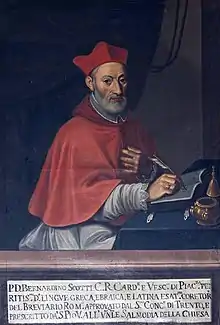Bernardino Scotti | |
|---|---|
| Cardinal, Bishop of Piacenza | |
 | |
| Church | Catholic Church |
| See | Piacenza |
| Appointed | 9 August 1559 |
| Term ended | 23 July 1568 |
| Predecessor | Catalano Trivulzio |
| Successor | Paolo Burali d'Arezzo |
| Other post(s) | Cardinal Priest of San Matteo in Merulana |
| Orders | |
| Consecration | 25 April 1560 (Bishop) by Cardinal Jean Suau |
| Created cardinal | 20 December 1555 by Pope Paul IV |
| Personal details | |
| Born | c. 1493 |
| Died | 2 December 1568 (aged 74–75) Rome |
| Buried | San Paolo fuori le Mura |
Bernardino Scotti (or Gianbernardino, c. 1493 – 1568) was an Italian cardinal. Near to the stern positions of Pope Paul IV, he was exponent of the Catholic Reformation. After the death of Pope Paul IV, he moved to his diocese of Piacenza where he repressed any Protestant dissent.
Biography
Gianbernardino Scotti was born in Magliano Sabina ca. 1493, the son of a noble family.[1] He was an expert in Greek, Hebrew, and in canon law. He entered the order of the Theatines in 1525, and is believed to be the first man to receive the Theatine habit.[1] Escaped from Rome after the Sack of Rome, in 1527 along with other Theatines he moved to Venice where they lived in the church of Tolentini.[2]
In 1536 Scotti returned to Rome, where he represented his religious order in many affairs. He worked also to merge the Theatines with the Somaschi Fathers, a merge that lasted only about ten years.[2] In 1548, he accompanied Luigi Lippomano, Bishop of Verona during the bishop's nunciature in Germany. Returning from Germany, he moved to Venice where he was appointed Prior of the Theatine house at Tolentini's church.[1]
In 1555, Pope Paul IV, one of the founders of the Theatine Order, summoned Scotti to Rome, making him Archbishop of Trani and cardinal priest in the consistory of 20 December 1555.[1] He received the red hat and the titular church of San Matteo in Via Merulana on 13 January 1556.[1] However he never took possession of his diocese of Trani because the Habsburgs never endorsed his appointment.[2]
In Rome under Paul IV he cooperated to the preparation of the Index Librorum Prohibitorum and in drafting the new Breviary. He worked for the Roman Inquisition, in the posthumous process against Girolamo Savonarola and in 1558 in the first process against Cardinal Giovanni Morone. The Pope assigned to him the revenues of the Abbey of Eboli previously assigned to Cardinal Morone.[2] On 9 August 1559 he was transferred to the see of Piacenza.[3]
He participated in the papal conclave of 1559 that elected Pope Pius IV.[1] The new Pope started a purge against the people who had been near to the previous Pope, such as Cardinal Carlo Carafa. Scotti therefore decided to move from Rome in his new diocese,[2] after having been consecrated bishop on 25 April 1560 by Cardinal Jean Suau.
In Piacenza he repressed any Protestant dissent. Marginalized, he tried to remain independent from the political influence of Charles Borromeo. He returned in Rome only after the papal conclave of 1565-66 that elected Pope Pius V.[1] The new pope made him a member of the Roman Inquisition, and placed him in charge of the affairs of the Eastern Catholic Churches.[1] He resigned the government of Piacenza sometime before 23 July 1568 to another Theatine, Paolo Burali d'Arezzo.[2]
He died in Rome on 2 December 1568.[2] He was buried in the Basilica of San Paolo fuori le Mura.[2]
References
- 1 2 3 4 5 6 7 8 Miranda, Salvador. "SCOTTI, Theat., Gianbernardino". The Cardinals of the Holy Roman Church. Florida International University. OCLC 53276621. Retrieved 3 July 2023.
- 1 2 3 4 5 6 7 8 Vanni, Andrea (2018). "Scotti, Bernardino". Dizionario Biografico degli Italiani, Volume 91: Savoia–Semeria (in Italian). Rome: Istituto dell'Enciclopedia Italiana. ISBN 978-8-81200032-6.
- ↑ David Cheney. "Bernardino Cardinal Scotti". Catholic-Hierarchy.org. Retrieved 3 July 2023.